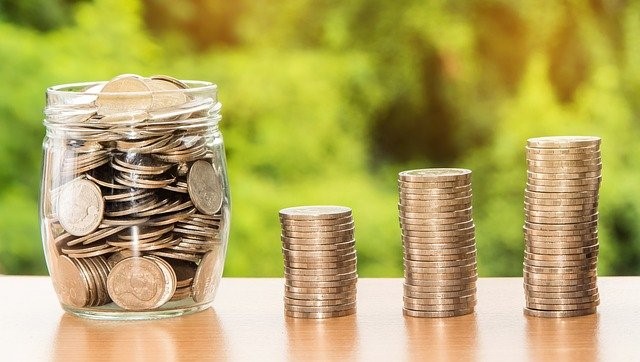What is a sinking fund?
A sinking fund is simply a savings account you expect to use for future purchases. This is different from an emergency fund in which you hope you don’t have to spend.
Is there something you are hoping to pay cash for in the future? For instance, new appliances, property taxes, license plate renewal, holiday gifts, vet bills, etc.
A sinking fund allows you to set money aside for those future purchases without dipping into your emergency fund.
First, we’ll look at how a sinking fund works and how to build it.
Secondly, we’ll review the different types of reasons you will build a sinking fund.
Thirdly, we’ll discuss how much should be in your sinking fund and what account to keep it in.
Also, throughout this post, you’ll discover there are actually many different ways to describe what a sinking fund is for clarity. Let’s Go!
How Does a Sinking Fund Work
A sinking fund can work in many different ways for you. However, for the sake of argument, every month you’ll set aside an amount into a savings account separate from your emergency fund.
Once you have reached your financial goal in the sinking fund. You will withdraw the cash to make the new purchase.
What is a sinking fund? It is a way to prevent you from spending more money than you need to.

What a sinking fund allows you to do
Avoid interest charges:
You’ll no longer need to finance new appliances or windows for your home. Using a sinking fund will allow you to save for these large purchases in order to pay in cash.
Your emergency fund stays intact:
Your emergency funds can stay right where they are. Additionally, you will not experience a situation requiring you to decide to deplete emergency funds or finance to make large purchases.
More Articles You May Be Interested In:
What Makes Your Credit Score Go Up
What is Financial Anxiety And How To Calm It
How To Break A Bad Habit In Your Finances
Pay off debt in lump sums:
Not to mention, if you are more interested in paying off debt faster, you can use these funds to make lump sum payments.
Using this method, I was able to pay off large lump sums of my high interest debt every 6 months while focusing on paying off my smallest debt aggressively.
It is amazing how $100 per month can add up!
Stop impulse purchasing
Building a sinking fund helps you really focus on which purchases actually mean the most to you, equally important.
Before buying an item, ask yourself, “Is this really worth saving for? Will I actually use it or is it retail therapy?”
Start earning income from the interest of a savings account
As you are saving your sinking funds, you could be earning high interest on the money if it is in the right savings account.
Instead of opening just any old savings account with your current bank, shop around for a savings account that offers the highest possible interest rate.
The result, you’ll save your money twice as fast. Who wouldn’t want that!

How to start building a sinking fund
Do. Not. Panic. This is easier than you think. Do you have at least $500 in your emergency savings?
Then the next part is easy. Look at the amount you are setting aside every month to build your emergency savings.
Decide what percentage of that total you want to go into your sinking fund and how much you want to go into your emergency fund.
For example – In the beginning I could only afford $115 to go into my savings every month, total.
I decided to put 60% ($115 x 0.60 = $69) in my emergency fund and the remaining 40% ($115 x 0.40 = $46) into my sinking fund.
As a result, I am still building my emergency fund while starting a sinking fund.
Important Tip For Beginners
As you are starting out, always put a majority of your savings into the emergency fund. Especially when your monthly savings is small.
Your emergency funds are the most important to you right now.
Furthermore, only start with one sinking fund so you do not spread yourself too thin. My first sinking fund was for my dogs vet bills every 6 months.
I didn’t always have enough in my sinking fund to cover all of the bills since my monthly savings was so small.
Nevertheless, as I paid off my small debts I freed up more money to put into savings. Consequently, this increased how much I could save in my sinking fund.
More Articles You May Be Interested In:
What Makes Your Credit Score Go Up
What is Financial Anxiety And How To Calm It
How To Break A Bad Habit In Your Finances
The great thing about building a sinking fund this way is you do not need to change how much you are currently saving per month.
If you are unable to save money at all right now focus on paying off your smallest debts until you finally have extra cash each month. In 2017, my bills were more than I brought home.
Once I paid off my three smallest monthly bills, I was able to, finally, start building a savings.
Also, consider contacting your credit card companies to request a hardship program. This will help temporarily stop the interest accrual on your high interest credit cards while you make your monthly minimum payments.
You can finally catch up!
Subscribe and you'll receive our weekly posts right in your inbox. You'll also be one of the first to be notified when our free budget course opens. Hope to see you there!
What Are Some Examples of Sinking Funds
Without further ado, here is an example list of why people will build sinking funds. This is not an exhaustive list. Also, remember to start small.
- Vet Bills
- Birthdays
- Holiday Gifts
- Vacations
- Subscriptions you are charged once per year (Amazon Prime)
- New home appliances
- Down payment for a new car or home
- Home Maintenance
- Property Taxes
- Medical Bills
- Vision Care – Eye glass frames aren’t always covered
- Dentist Care
- Seasonal fun – Theme parks, water parks, zoo, museums, etc
- Self-Care – Massage, facial, day out with the girls, hair styling
- Income Taxes

How Much Should You Have in a Sinking Fund
What is a sinking fund again? It is a savings fund to use for large future purchases. This means it is a short-term savings fund.
How much you put into it varies based on what your savings goal is. If you don’t know right now that is perfectly fine.
Just start putting money into it. Something will always come up in the future.
To figure out what to save for, review your bank statements from the last year. Is there a bill you pay yearly that always hurts your budget?
How much did you pay for that bill last year? If you made payments add all of the monthly payments together to get to the lump sum.
Make that total your sinking fund goal amount.
Next, look at your records to see when you started paying the bill. This will give you an idea as to when it will come due again.
How many months do you have left to start saving before you need to start paying? Divide the amount you paid in total by the number of months you have left to save.
The final number is how much you’ll need to save per month in order to pay the bill in full.
Do not freak out! If you do not have enough time to save for the entire amount that is ok.
The goal is to save something so you can make a large first payment in cash. Then you can make monthly payments after that.
Additionally, next year you’ll be able to save the entire lump sum and kiss monthly payments goodbye.

Where to Keep Your Sinking Fund
I recommend finding a high-interest savings account, even if it is at a different bank. As of this writing, the highest interest rate is 0.61% and the lowest is 0.01%.
Also, make sure you can get to your funds quickly when you need them. Do not use an account that relies on investing in the stock market.
The total value of the account is not guaranteed since the stock market can drop at any time. You also don’t want to be forced to sell off quickly because you need the money now.
If you are not familiar with the bank you are looking at, pay attention to the google reviews. You can also ask if anyone has experiences with the new bank within reddit financial forums and facebook groups.
Similarly, stay away from CD’s; you are charged penalties if you withdraw from the account early.
Then at maturity, you have to either move the funds to another account or agree to another long-term lockdown of your money.
More Articles You May Be Interested In:
What Makes Your Credit Score Go Up
What is Financial Anxiety And How To Calm It
How To Break A Bad Habit In Your Finances
Your Take Action Guide
If you are not familiar with my style of writing, I always like to give you a systematic plan to start implementing what you learned in each post.
However, this is just a starting point for you. As you practice, please tweak any part of the plan to fit your current situation.
Start Your Sinking Fund
Step One: What do you need to save for the most right now? How much do you need to reach your savings goal?
Step 2: Next, decide what percentage of what you currently save per month you want to go into your emergency fund. The rest will go into your sinking fund.
Final Step 3: Search around for a high interest savings account to house your sinking fund. Refer to the “where to keep your sinking fund” section to learn how to vet out a new bank.
Now, it is easy to look at the examples listed above and go crazy building sinking funds. The sinking fund is just another tool for you to take advantage of while you are paying off your debt.
Only build one sinking fund for right now.
In the end, the main idea is to stay on track with getting out of debt for good. As you free up more cash each month you can decide to put more into savings.
I started with $85K in debt and now I only have $35K left to pay. Now I have $708.00 per month freed up in my budget.
I send all of that money to my savings account now. Since I am able to save so much, I now have five sinking funds and an emergency fund in total.
All six savings accounts receive a portion of my monthly savings deposit.
If you start one sinking fund now alongside your emergency fund this will be you in the future. Do not get discouraged, it takes time.
The important thing is you get it started now. As with everything in your finances, the sooner you start something.
The sooner, you will start to see the benefits. You can do this!
References
https://www.huffpost.com/entry/sinking-fund-definition_l_5e4c7bf6c5b65f25da50fcb0
https://bettermoneyhabits.bankofamerica.com/en/personal-banking/what-is-a-cd-investment
https://www.bankrate.com/banking/cds/what-to-do-when-cd-matures/
Subscribe and you'll receive our weekly posts right in your inbox. You'll also be one of the first to be notified when our free budget course opens. Hope to see you there!





